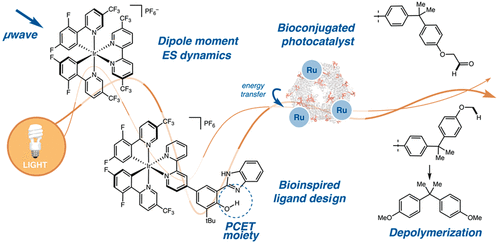当前位置:
X-MOL 学术
›
Acc. Chem. Res.
›
论文详情
Our official English website, www.x-mol.net, welcomes your
feedback! (Note: you will need to create a separate account there.)
Bioinspired Supercharging of Photoredox Catalysis for Applications in Energy and Chemical Manufacturing
Accounts of Chemical Research ( IF 16.4 ) Pub Date : 2022-04-26 , DOI: 10.1021/acs.accounts.2c00083 Agustin Millet 1 , Paul T Cesana 2 , Kassandra Sedillo 1 , Matthew J Bird 3 , Gabriela S Schlau-Cohen 2 , Abigail G Doyle 1, 4 , David W C MacMillan 1 , Gregory D Scholes 1
Accounts of Chemical Research ( IF 16.4 ) Pub Date : 2022-04-26 , DOI: 10.1021/acs.accounts.2c00083 Agustin Millet 1 , Paul T Cesana 2 , Kassandra Sedillo 1 , Matthew J Bird 3 , Gabriela S Schlau-Cohen 2 , Abigail G Doyle 1, 4 , David W C MacMillan 1 , Gregory D Scholes 1
Affiliation

|
For more than a decade, photoredox catalysis has been demonstrating that when photoactive catalysts are irradiated with visible light, reactions occur under milder, cheaper, and environmentally friendlier conditions. Furthermore, this methodology allows for the activation of abundant chemicals into valuable products through novel mechanisms that are otherwise inaccessible. The photoredox approach, however, has been primarily used for pharmaceutical applications, where its implementation has been highly effective, but typically with a more rudimentary understanding of the mechanisms involved in these transformations. From a global perspective, the manufacture of everyday chemicals by the chemical industry as a whole currently accounts for 10% of total global energy consumption and generates 7% of the world’s greenhouse gases annually. In this context, the Bio-Inspired Light-Escalated Chemistry (BioLEC) Energy Frontier Research Center (EFRC) was founded to supercharge the photoredox approach for applications in chemical manufacturing aimed at reducing its energy consumption and emissions burden, by using bioinspired schemes to harvest multiple electrons to drive endothermically uphill chemical reactions. The Center comprises a diverse group of researchers with expertise that includes synthetic chemistry, biophysics, physical chemistry, and engineering. The team works together to gain a deeper understanding of the mechanistic details of photoredox reactions while amplifying the applications of these light-driven methodologies.
中文翻译:

光氧化还原催化的仿生增压在能源和化学制造中的应用
十多年来,光氧化还原催化已经证明,当用可见光照射光活性催化剂时,反应会在更温和、更便宜和更环保的条件下发生。此外,这种方法允许通过其他方式无法访问的新机制将丰富的化学物质激活为有价值的产品。然而,光氧化还原方法主要用于制药应用,其实施非常有效,但通常对这些转化所涉及的机制有更基本的了解。从全球范围看,目前整个化工行业生产的日用化学品占全球能源消耗总量的10%,每年产生的温室气体占全球的7%。在此背景下,仿生光升级化学 (BioLEC) 能源前沿研究中心 (EFRC) 的成立旨在增强光氧化还原方法在化学制造中的应用,旨在通过使用仿生计划收获来减少其能源消耗和排放负担多个电子来驱动吸热的上坡化学反应。该中心由一群具有专业知识的研究人员组成,包括合成化学、生物物理学、物理化学和工程学。该团队共同努力,以更深入地了解光氧化还原反应的机制细节,同时扩大这些光驱动方法的应用。Bio-Inspired Light-Escalated Chemistry (BioLEC) 能源前沿研究中心 (EFRC) 的成立旨在增强光氧化还原方法在化学制造中的应用,旨在减少其能源消耗和排放负担,通过使用仿生方案收集多个电子来驱动吸热上升的化学反应。该中心由一群具有专业知识的研究人员组成,包括合成化学、生物物理学、物理化学和工程学。该团队共同努力,以更深入地了解光氧化还原反应的机制细节,同时扩大这些光驱动方法的应用。Bio-Inspired Light-Escalated Chemistry (BioLEC) 能源前沿研究中心 (EFRC) 的成立旨在增强光氧化还原方法在化学制造中的应用,旨在减少其能源消耗和排放负担,通过使用仿生方案收集多个电子来驱动吸热上升的化学反应。该中心由一群具有专业知识的研究人员组成,包括合成化学、生物物理学、物理化学和工程学。该团队共同努力,以更深入地了解光氧化还原反应的机制细节,同时扩大这些光驱动方法的应用。通过使用受生物启发的方案来收集多个电子来驱动吸热的上坡化学反应。该中心由一群具有专业知识的研究人员组成,包括合成化学、生物物理学、物理化学和工程学。该团队共同努力,以更深入地了解光氧化还原反应的机制细节,同时扩大这些光驱动方法的应用。通过使用受生物启发的方案来收集多个电子来驱动吸热的上坡化学反应。该中心由一群具有专业知识的研究人员组成,包括合成化学、生物物理学、物理化学和工程学。该团队共同努力,以更深入地了解光氧化还原反应的机制细节,同时扩大这些光驱动方法的应用。
更新日期:2022-04-26
中文翻译:

光氧化还原催化的仿生增压在能源和化学制造中的应用
十多年来,光氧化还原催化已经证明,当用可见光照射光活性催化剂时,反应会在更温和、更便宜和更环保的条件下发生。此外,这种方法允许通过其他方式无法访问的新机制将丰富的化学物质激活为有价值的产品。然而,光氧化还原方法主要用于制药应用,其实施非常有效,但通常对这些转化所涉及的机制有更基本的了解。从全球范围看,目前整个化工行业生产的日用化学品占全球能源消耗总量的10%,每年产生的温室气体占全球的7%。在此背景下,仿生光升级化学 (BioLEC) 能源前沿研究中心 (EFRC) 的成立旨在增强光氧化还原方法在化学制造中的应用,旨在通过使用仿生计划收获来减少其能源消耗和排放负担多个电子来驱动吸热的上坡化学反应。该中心由一群具有专业知识的研究人员组成,包括合成化学、生物物理学、物理化学和工程学。该团队共同努力,以更深入地了解光氧化还原反应的机制细节,同时扩大这些光驱动方法的应用。Bio-Inspired Light-Escalated Chemistry (BioLEC) 能源前沿研究中心 (EFRC) 的成立旨在增强光氧化还原方法在化学制造中的应用,旨在减少其能源消耗和排放负担,通过使用仿生方案收集多个电子来驱动吸热上升的化学反应。该中心由一群具有专业知识的研究人员组成,包括合成化学、生物物理学、物理化学和工程学。该团队共同努力,以更深入地了解光氧化还原反应的机制细节,同时扩大这些光驱动方法的应用。Bio-Inspired Light-Escalated Chemistry (BioLEC) 能源前沿研究中心 (EFRC) 的成立旨在增强光氧化还原方法在化学制造中的应用,旨在减少其能源消耗和排放负担,通过使用仿生方案收集多个电子来驱动吸热上升的化学反应。该中心由一群具有专业知识的研究人员组成,包括合成化学、生物物理学、物理化学和工程学。该团队共同努力,以更深入地了解光氧化还原反应的机制细节,同时扩大这些光驱动方法的应用。通过使用受生物启发的方案来收集多个电子来驱动吸热的上坡化学反应。该中心由一群具有专业知识的研究人员组成,包括合成化学、生物物理学、物理化学和工程学。该团队共同努力,以更深入地了解光氧化还原反应的机制细节,同时扩大这些光驱动方法的应用。通过使用受生物启发的方案来收集多个电子来驱动吸热的上坡化学反应。该中心由一群具有专业知识的研究人员组成,包括合成化学、生物物理学、物理化学和工程学。该团队共同努力,以更深入地了解光氧化还原反应的机制细节,同时扩大这些光驱动方法的应用。











































 京公网安备 11010802027423号
京公网安备 11010802027423号